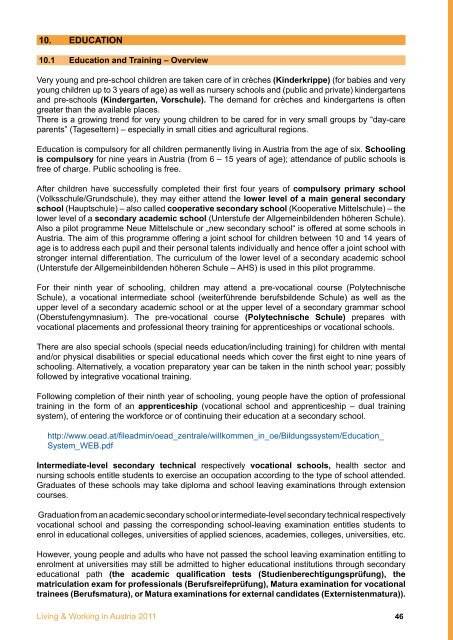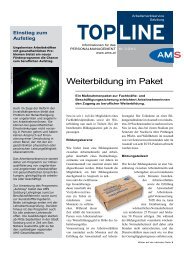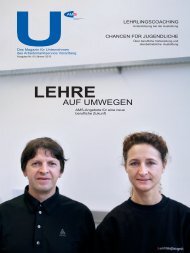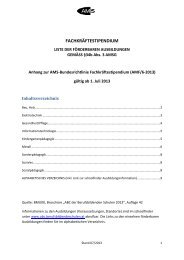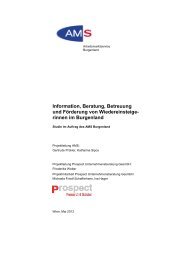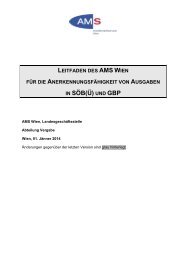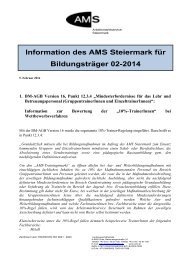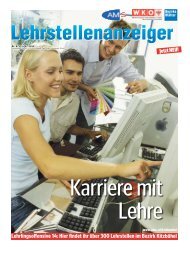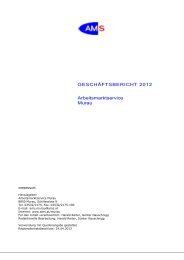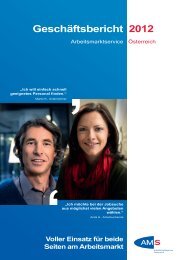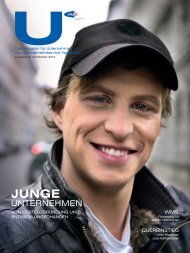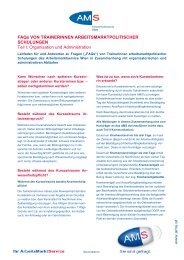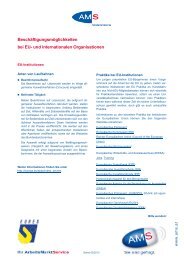Living & Working in Austria
Living & Working in Austria
Living & Working in Austria
Create successful ePaper yourself
Turn your PDF publications into a flip-book with our unique Google optimized e-Paper software.
10. EDUCATION<br />
10.1 Education and Tra<strong>in</strong><strong>in</strong>g – Overview<br />
Very young and pre-school children are taken care of <strong>in</strong> crèches (K<strong>in</strong>derkrippe) (for babies and very<br />
young children up to 3 years of age) as well as nursery schools and (public and private) k<strong>in</strong>dergartens<br />
and pre-schools (K<strong>in</strong>dergarten, Vorschule). The demand for crèches and k<strong>in</strong>dergartens is often<br />
greater than the available places.<br />
There is a grow<strong>in</strong>g trend for very young children to be cared for <strong>in</strong> very small groups by “day-care<br />
parents” (Tageseltern) – especially <strong>in</strong> small cities and agricultural regions.<br />
Education is compulsory for all children permanently liv<strong>in</strong>g <strong>in</strong> <strong>Austria</strong> from the age of six. School<strong>in</strong>g<br />
is compulsory for n<strong>in</strong>e years <strong>in</strong> <strong>Austria</strong> (from 6 – 15 years of age); attendance of public schools is<br />
free of charge. Public school<strong>in</strong>g is free.<br />
After children have successfully completed their first four years of compulsory primary school<br />
(Volksschule/Grundschule), they may either attend the lower level of a ma<strong>in</strong> general secondary<br />
school (Hauptschule) – also called cooperative secondary school (Kooperative Mittelschule) – the<br />
lower level of a secondary academic school (Unterstufe der Allgeme<strong>in</strong>bildenden höheren Schule).<br />
Also a pilot programme Neue Mittelschule or „new secondary school“ is offered at some schools <strong>in</strong><br />
<strong>Austria</strong>. The aim of this programme offer<strong>in</strong>g a jo<strong>in</strong>t school for children between 10 and 14 years of<br />
age is to address each pupil and their personal talents <strong>in</strong>dividually and hence offer a jo<strong>in</strong>t school with<br />
stronger <strong>in</strong>ternal differentiation. The curriculum of the lower level of a secondary academic school<br />
(Unterstufe der Allgeme<strong>in</strong>bildenden höheren Schule – AHS) is used <strong>in</strong> this pilot programme.<br />
For their n<strong>in</strong>th year of school<strong>in</strong>g, children may attend a pre-vocational course (Polytechnische<br />
Schule), a vocational <strong>in</strong>termediate school (weiterführende berufsbildende Schule) as well as the<br />
upper level of a secondary academic school or at the upper level of a secondary grammar school<br />
(Oberstufengymnasium). The pre-vocational course (Polytechnische Schule) prepares with<br />
vocational placements and professional theory tra<strong>in</strong><strong>in</strong>g for apprenticeships or vocational schools.<br />
There are also special schools (special needs education/<strong>in</strong>clud<strong>in</strong>g tra<strong>in</strong><strong>in</strong>g) for children with mental<br />
and/or physical disabilities or special educational needs which cover the first eight to n<strong>in</strong>e years of<br />
school<strong>in</strong>g. Alternatively, a vocation preparatory year can be taken <strong>in</strong> the n<strong>in</strong>th school year; possibly<br />
followed by <strong>in</strong>tegrative vocational tra<strong>in</strong><strong>in</strong>g.<br />
Follow<strong>in</strong>g completion of their n<strong>in</strong>th year of school<strong>in</strong>g, young people have the option of professional<br />
tra<strong>in</strong><strong>in</strong>g <strong>in</strong> the form of an apprenticeship (vocational school and apprenticeship – dual tra<strong>in</strong><strong>in</strong>g<br />
system), of enter<strong>in</strong>g the workforce or of cont<strong>in</strong>u<strong>in</strong>g their education at a secondary school.<br />
http://www.oead.at/fileadm<strong>in</strong>/oead_zentrale/willkommen_<strong>in</strong>_oe/Bildungssystem/Education_<br />
System_WEB.pdf<br />
Intermediate-level secondary technical respectively vocational schools, health sector and<br />
nurs<strong>in</strong>g schools entitle students to exercise an occupation accord<strong>in</strong>g to the type of school attended.<br />
Graduates of these schools may take diploma and school leav<strong>in</strong>g exam<strong>in</strong>ations through extension<br />
courses.<br />
Graduation from an academic secondary school or <strong>in</strong>termediate-level secondary technical respectively<br />
vocational school and pass<strong>in</strong>g the correspond<strong>in</strong>g school-leav<strong>in</strong>g exam<strong>in</strong>ation entitles students to<br />
enrol <strong>in</strong> educational colleges, universities of applied sciences, academies, colleges, universities, etc.<br />
However, young people and adults who have not passed the school leav<strong>in</strong>g exam<strong>in</strong>ation entitl<strong>in</strong>g to<br />
enrolment at universities may still be admitted to higher educational <strong>in</strong>stitutions through secondary<br />
educational path (the academic qualification tests (Studienberechtigungsprüfung), the<br />
matriculation exam for professionals (Berufsreifeprüfung), Matura exam<strong>in</strong>ation for vocational<br />
tra<strong>in</strong>ees (Berufsmatura), or Matura exam<strong>in</strong>ations for external candidates (Externistenmatura)).<br />
<strong>Liv<strong>in</strong>g</strong> & <strong>Work<strong>in</strong>g</strong> <strong>in</strong> <strong>Austria</strong> 2011<br />
46


